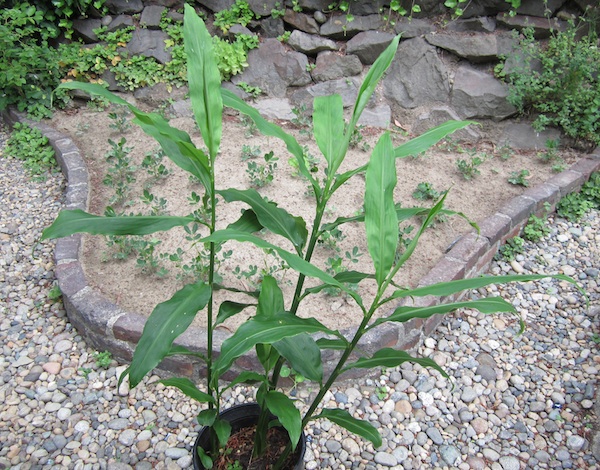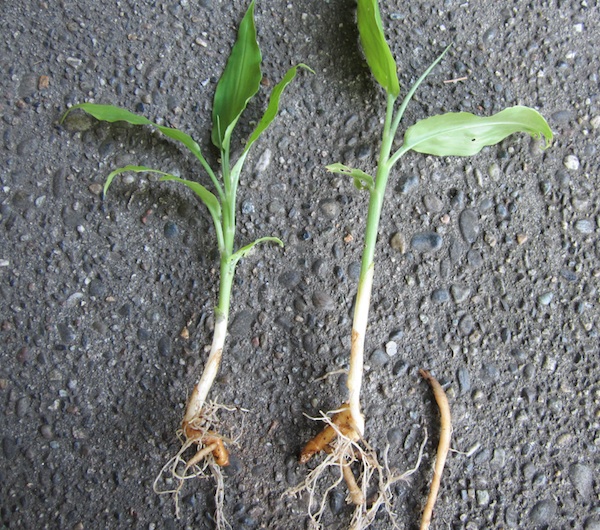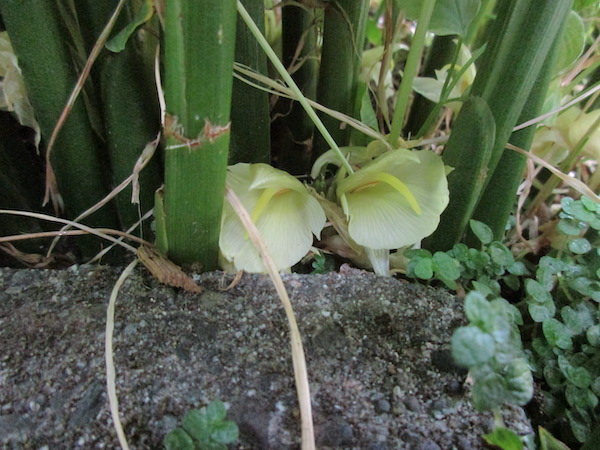Plant of the Month: July 2012
|
| Japanese Ginger in Seattle |
| Zingiber Mioga (Thunb. ex Murr.) Rosc. |
ZINGIBERACEÆ; Ginger Family
|
| Native certainly in parts of SE China, and cultivated much if not native in Japan and S Korea, Japanese Ginger is a woodland perennial that turns yellow and dies down in fall, rests during the cold winter, then shoots up again next spring, growing about 3 to 4 feet in height. Most Zingiber species are cold-sensitive; this one is hardy. |
| The original edible ginger, a well known spice plant, is Zingiber officinale Rosc., also called the Common, Edible, True, or Canton Ginger. It is a sterile tropical species of human origin likely from NE India or S China. Its ground or grated root is a popular spice. Moreover, according to Stephen Facciola's 1998 book Cornucopia II, its "very young rhizomes [tuberous roots] --known as stem ginger, young ginger, or green ginger-- are peeled and eaten raw in salads, pickled, or cooked in syrup and made into sweetmeats. Young, slightly spicy shoots eaten as a potherb or puréed and used in sauces and dips." |
| Chinese names of Zingiber Mioga are transliterated xing he = yang-he (sun lotus); or rang he = jang-ho (wild ginger). The Japanese name is Mioga or Myoga ミョウ. |
| Of Japanese Ginger, Facciola wrote: "Young shoots are blanched and used in soups, tempura and tofu dishes, adding a pleasant spicy aroma and flavor. They are also pickled or chopped finely and used as a garnish for sashimi. The aromatic pale yellow flowers, having a sharp flavor, are added to soups, fried foods, and vinegared dishes." Actually, the flower buds are preferred. |
| There are about 140 species of Zingiber, all Old World. At least 5 other Zingiber species, in addition to Zingiber Mioga and Zingiber officnale, are reported as being eaten besides as a mere condiment. |
| Japanese Ginger is easily grown in rich, moist soil, in shade. Too much sun or dryness stunts it. Dividing the plant stimulates better growth. Because Seattle has cold springs, it takes its time "waking up" here, and the tender young growth is sometimes enjoyed by slugs or snails. Growing it in a black container that will warm the soil more quickly, may be desirable. |
| Sometimes it blooms, in late summer: inconspicuous pale yellow or white flowers down near the ground. A colorful description: "They sort of look like young pine cones on a stick." The leaves are at most about 13 inches long and 3 inches wide --much wider than those of the Common Ginger. |
| A white-variegated leaf cultivar is 'Dancing Crane' planted as an ornamental; 'Silver Arrow' foliage emerges "parchment gold and becomes flecked green with a delicious butterscotch frosting;" 'White Feather' leaves are "edged in creamy yellow that fades to creamy white." |
Though Japanese Ginger is in no sense a culinary replacement for Common Ginger, I like to eat Japanese Ginger's tender leaves. The leaves are only tender when very young; they quickly turn fibrous and chewy. The younger portions of tuberous roots are also edible, but their flavor is less pronounced than that of the leaves. Since it is easy to grow Common Ginger as a houseplant, the main value of Japanese Ginger is either as an ornamental in shade, or to harvest the young leaves, repeatedly --or the flowers if and when they appear.
Back
|

Japanese Ginger in a pot; photo by ALJ
|

Japanese Ginger roots on a small specimen; photo by ALJ |

Japanese Ginger flowers; photo by ALJ |
|
|

